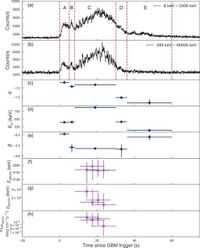Scientists have recently made significant headway in their understanding of gamma-ray bursts (GRBs), one of the universe's most powerful events. They have detected a narrow emission feature at approximately 2.1 mega-electron volts (MeV) in the spectrum of GRB 221023A, which occurred on October 23, 2022. This discovery, observed through the Fermi Gamma-Ray Burst Monitor, coincides with a time interval of 8 to 30 seconds after the burst's trigger, exhibiting an impressive significance greater than 4.20 sigma. This groundbreaking research offers new avenues for understanding the physics behind these cosmic explosions.
Gamma-ray bursts are characterized by their intense radiation and rapid emissions, typically lasting mere seconds to several minutes. Their origins are attributed to the relativistic jets that accelerate particles during stellar explosions. While previous studies focused on confirming absorption lines in GRB spectra, the current analysis brings forth the first reliable detection of a narrow emission feature in a GRB spectrum since a similar feature was reported for GRB 221009A. The discovery of such lines helps illuminate the composition and physical conditions of the surrounding GRB environment.
The investigation of GRB 221023A began when it triggered the Fermi Gamma-Ray Burst Monitor at 20:41:34.92 UTC. The detection resulted in a total duration of approximately 39 seconds in the 50-300 keV energy band, with a recorded fluence of 3.41 x 10^-4 erg cm^-2 between 10 and 1000 keV ranges. Notably, the Fermi Large Area Telescope captured a particularly energetic photon occurring 576 seconds post-trigger, accentuating the ongoing analysis of the event.
The study entailed a spectral analysis during multiple time intervals, with specific focus on the 8-30 seconds interval. A profound and discrete narrow emission feature was evident in the spectrum, further analyzed using a Gaussian modeling approach. This led to key parameters such as the narrow emission's central energy (approximately 2.1 MeV), its width, and related statistical significance assessed through model comparison techniques.
Results from the research revealed not only the specifics of the narrow feature but also indicated that its existence was significantly favored over simpler band models, evidenced by a significant ΔAIC value of 51.87. Through this rigorous statistical work, researchers underscored the importance of such emission lines for enriching our overall understanding of the mechanisms occurring during GRB phenomena.
Looking at the physical implications of these findings, scientists proposed several hypotheses regarding the mechanism responsible for the observed emission. The potential explanations include interactions between energetic particles and ambient matter, which excite nuclei resulting in emission via nuclear de-excitation mechanisms. This scenario indicates an energetic relationship among particles within the blast's relativistic jets, adding depth to current models on such astronomical events.
Additionally, the ongoing research highlights the differences observed between GRB 221023A and a notable event, GRB 221009A. While GRB 221009A exhibited a decreasing central energy over time, the central energy of the narrow emission feature in GRB 221023A remained stable at approximately 2.1 MeV throughout the display period. This variance opens further inquiry into the different environments shaped by distinct jet dynamics and physical compositions.
The full implications of this work are vast, pointing towards a more nuanced understanding of relativistic jets and their characteristics. As scientists continue to analyze these cosmic phenomena, the research on GRB 221023A lays foundational knowledge that may foster the discovery of new emission features in GRBs, guiding future investigations into the fundamental nature of our universe.
In summary, the detection of the narrow emission line in GRB 221023A introduces exciting new possibilities for the scientific community. As we continue to decode the messages sent by these distant stellar explosions, each discovery sheds light on the processes that govern our universe, ultimately bringing us closer to understanding its most profound mysteries.

